warning light CHEVROLET MONTE CARLO 1997 5.G Owners Manual
[x] Cancel search | Manufacturer: CHEVROLET, Model Year: 1997, Model line: MONTE CARLO, Model: CHEVROLET MONTE CARLO 1997 5.GPages: 358, PDF Size: 19.11 MB
Page 9 of 358
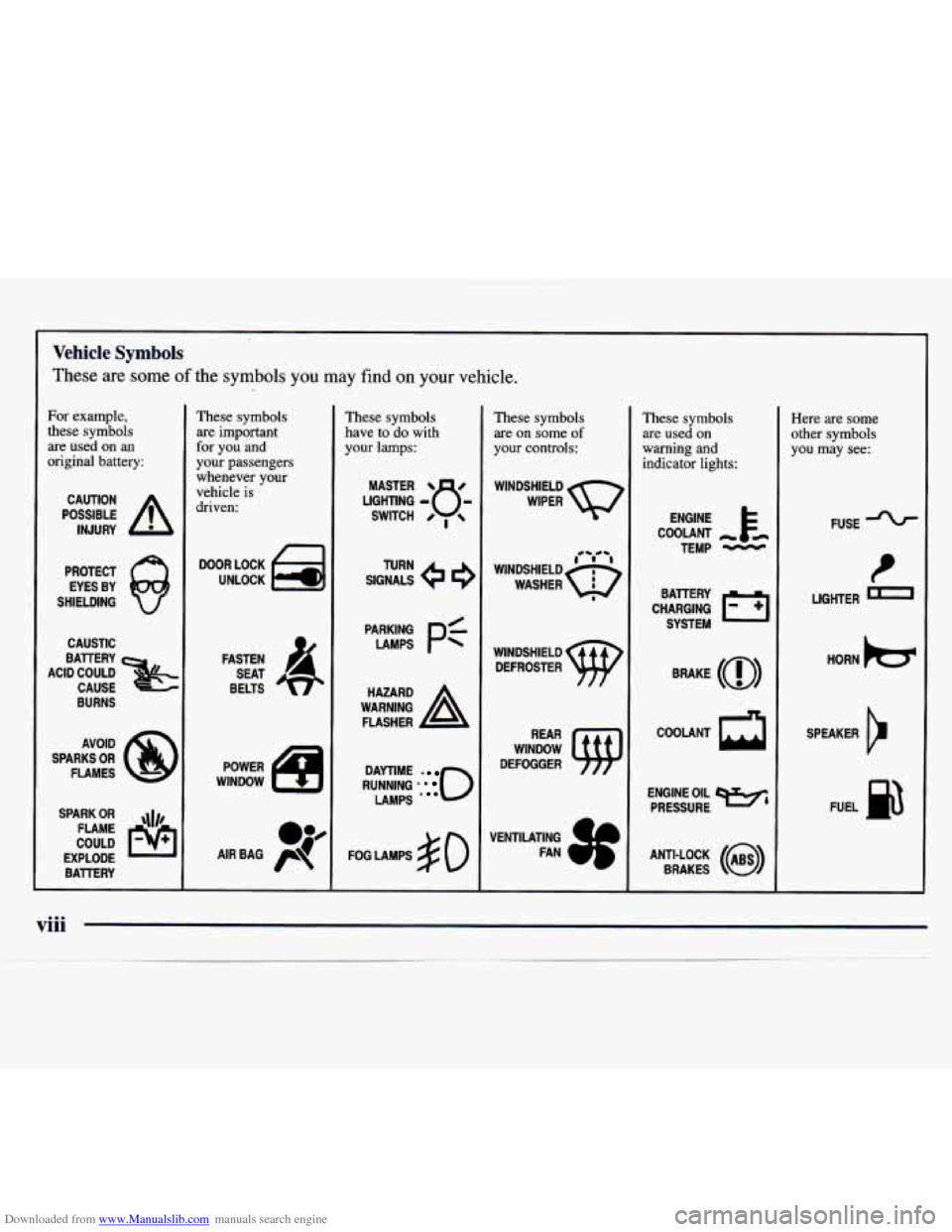
Downloaded from www.Manualslib.com manuals search engine Vehicle Symbols
These are some of the symbols you may find on your vehicle.
These symbols
are important
for you and
your passengers
whenever your
vehicle is
driven: These symbols
have
to do
with
your lamps: These symbols
are on some of
your
controls: These symbols
are used
on
warning and
indicator lights: Here
are some
other symbols
you may see: I For example,
' these symbols
are used
on an
original battery:
WINDSHIELD
WIPER
POSSIBLE
A
CAUTION
INJURY FUSE
COOLANT
TEMP
-
PROTECT EYES BY
SHIELDING
Q
SIGNALS e e
TURN
DOOR LOCK
UNLOCK
LIGHTER
CHARGING
1-1
BATTERY
SYSTEM
CAUSTIC HORN
)cr WINDSHIELD DEFROSTER BRAKE
(0)
FASTEN
SEAT
BELTS
BURNS
SPEAKER
b
COOLANT
a AVOID
SPARKS
OR
FLAMES
I
WINDOW
DEFOGGER
RUNNING
' 0
DAYTIME -
LAMPS * '
POWER
WINDOW ENGINE OIL
e,
PRESSURE FUEL B SPARK OR ,\I/,
COULD FLAME
EXPLODE BA'ITERY FOG LAMPS # 0
VENTILATING
FAN ANTI-LOCK
(@)
BRAKES
Page 60 of 358

Downloaded from www.Manualslib.com manuals search engine 0 Section 2 Features and Controls
Here you can learn about the many standard and optional features on your Chevrolet, and information on starting,
shifting and braking. Also explained are the instrument panel and
the warning systems that tell you if everything is
working properly -- and what to do if you have a problem.
2-2
2-4
2-5
2-8
2-9
2-10
2-12 2-12 2-13
2-15
2-16
2-20
2-2
I
2-24
2-24
2-25
2-25
Keys
Door Locks
Remote Keyless Entry (If Equipped)
Trunk
Theft PASS-Key@ I1
New Vehicle “Break-In”
Ignition Positions
Starting Your Engine
Engine Coolant Heater (Option)
Automatic Transaxle Operation
Parking Brake
Shifting Into PARK
(P)
Shifting Out of PARK (P)
Parking Over Things That Burn
Engine Exhaust
Running Your Engine While You’re Parked
2-26
2-27
2-27 2-27
2-33
2-35
2-36
2-3 8
2-40
2-40
2-42
2-43
2-44
2-46
2-48
Power Windows
Horn
Tilt Steering Wheel
Turn SignaVMultifunction Lever
Exterior Lamps Interior Lamps
Mirrors Storage Compartments
Ashtrays and Lighter
Sun Visors
Auxiliary Power Connection
Sunroof (Option)
Instrument Panel
-- Your
Information System
Instrument Panel Cluster
Warning Lights, Gages and Indicators
Page 72 of 358

Downloaded from www.Manualslib.com manuals search engine OFF (C): This position lets you turn off the engine but
still turn the steering wheel. It doesn’t lock the steering
wheel like LOCK. Use
OFF if you must have your
vehicle pushed or towed.
RUN (D): This position is where the key returns
after you
start your vehicle. With the engine off, you
can use RUN to display some of your warning and
indicator lights.
START (E): This position starts your engine.
A warning chime will sound if you open the driver’s
door when the ignition is in
OFF, LOCK or ACC and
the key is in the ignition.
I NOTICE:
If your key seems stuck in LOCK and you can’t
turn
it, be sure you are using the correct key; if
so, is it all the way in? If it is, then turn the
steering wheel left and right while you turn the
key hard. But turn the key only with your hand.
Using a tool to force
it could break the key or the
ignition switch. If none of this works, then your
vehicle needs service.
Starting Your Engine
Move your shift lever to PARK (P) or NEUTRAL (N).
Your engine won’t start in any other position
-- that’s a
safety feature.
To restart when you’re already moving,
use NEUTRAL (N) only.
NOTICE:
Don’t try to shift to PARK (P) if your Chevrolet
is moving.
If you do, you could damage the
transaxle. Shift to
PARK (P) only when your
vehicle
is stopped.
2-13
Page 92 of 358
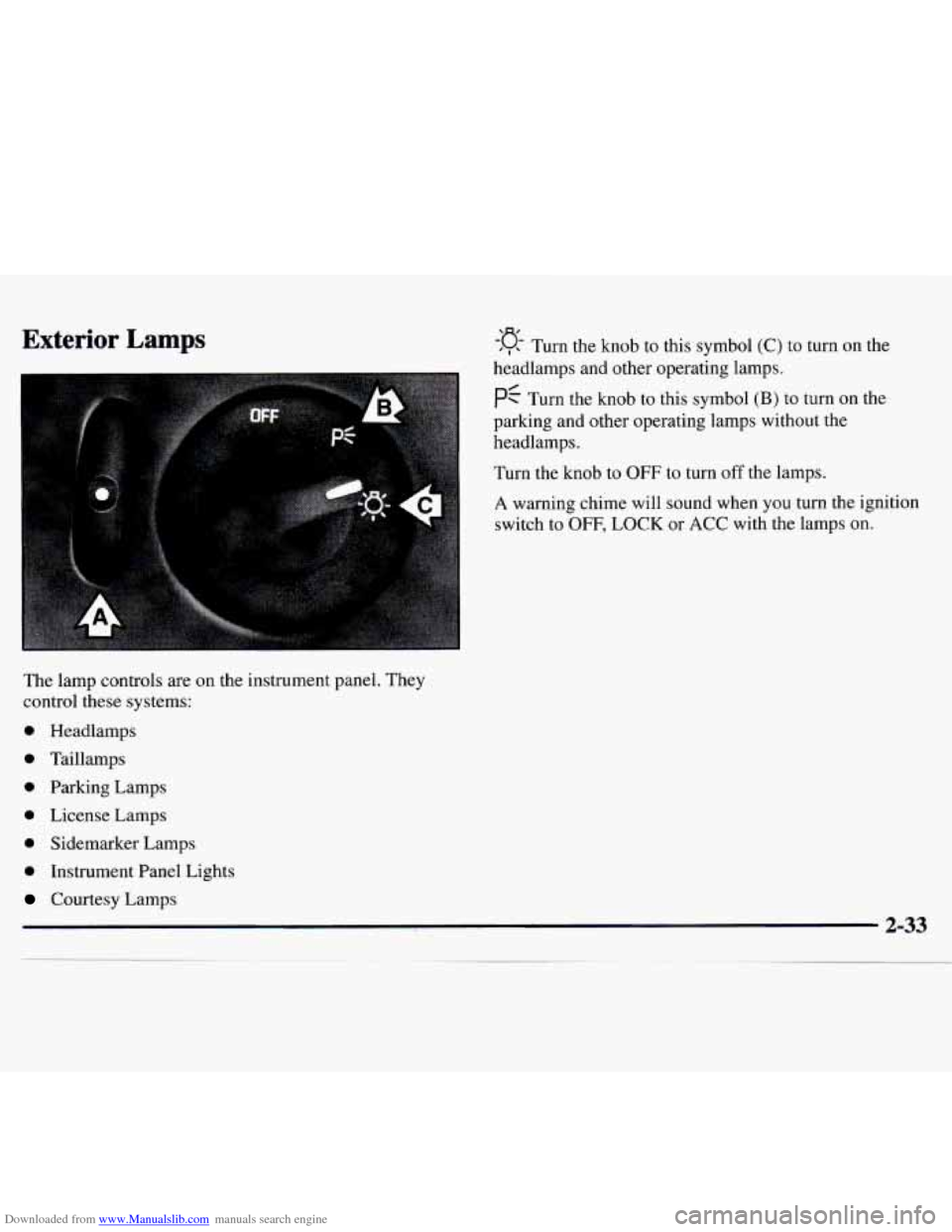
Downloaded from www.Manualslib.com manuals search engine Exterior Lamps -‘Q 0, Turn the knob to this symbol (C) to turn on the
headlamps and other operating lamps.
pf Turn the knob to this symbol (B) to turn on the
parking and other operating lamps without the
headlamps.
Turn the knob to
OFF to turn off the lamps.
A warning chime will sound when you turn the ignition
switch to
OFF, LOCK or ACC with the lamps on.
The lamp controls are on the instrument panel. They
control these systems:
0 Headlamps
0 Taillamps
0 Parking Lamps
0 License Lamps
0 Sidemarker Lamps
0 Instrument Panel Lights
Courtesy Lamps
2-33
Page 107 of 358
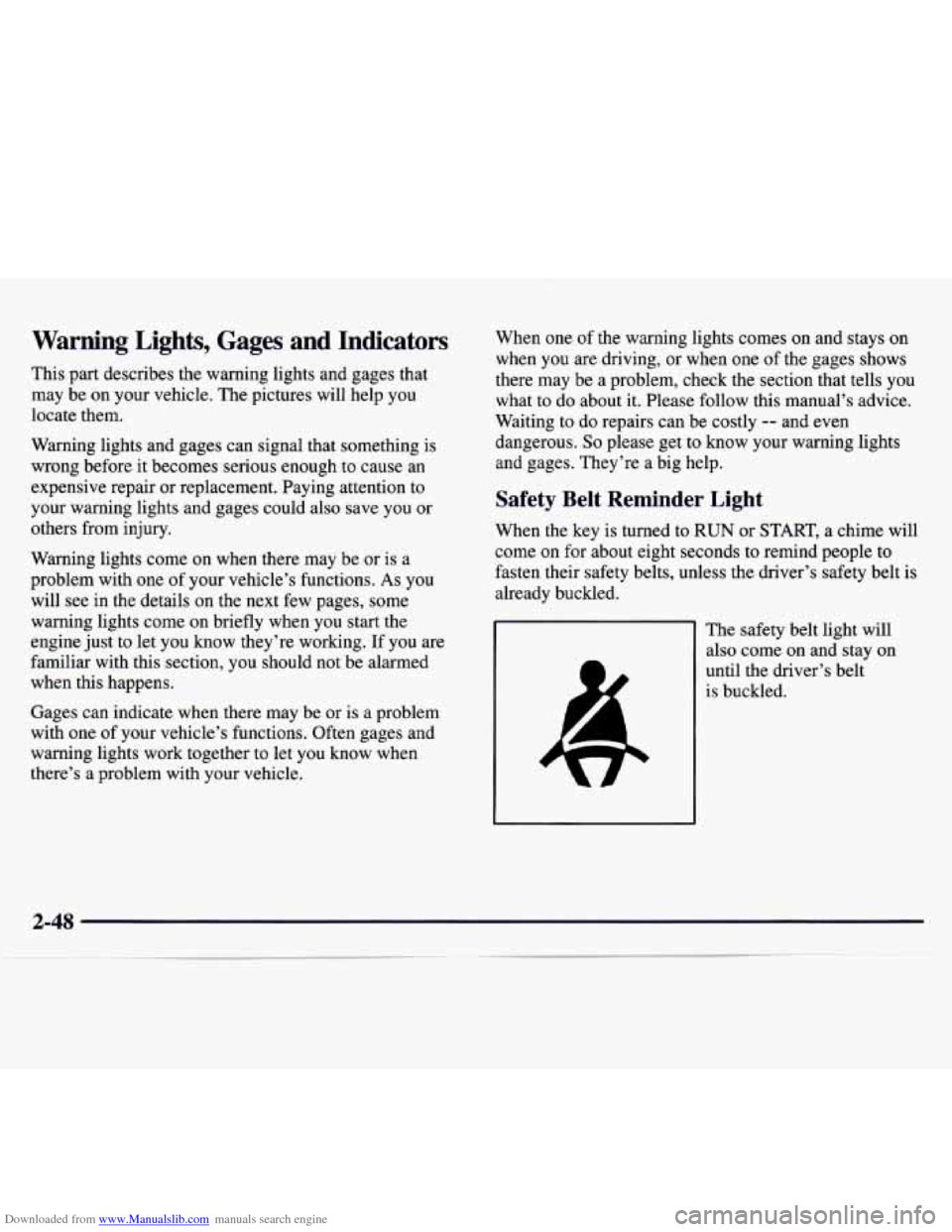
Downloaded from www.Manualslib.com manuals search engine Warning Lights, Gages and Indicators
This part describes the warning lights and gages that
may be on your vehicle. The pictures will help you
locate them.
Warning lights and gages can signal that something is
wrong before it becomes serious enough to cause an
expensive repair or replacement. Paying attention to
your warning lights and gages could also save you or
others from injury.
Warning lights come on when there may be or is a
problem with one
of your vehicle’s functions. As you
will see in the details on the next few pages, some
warning lights come on briefly when you start the
engine just to let you know they’re working.
If you are
familiar with this section, you should not be alarmed
when this happens.
Gages can indicate when there may be or is a problem
with one of your vehicle’s functions. Often gages and
warning lights work together to let you know when
there’s a problem with your vehicle. When
one
of the warning lights comes on and stays on
when you are driving, or when one of the gages shows
there may be a problem, check the section that tells you
what to do about it. Please follow this manual’s advice.
Waiting to do repairs can be costly
-- and even
dangerous.
So please get to know your warning lights
and gages. They’re a big help.
Safety Belt Reminder Light
When the key is turned to RUN or START, a chime will
come on for about eight seconds to remind people to
fasten their safety belts, unless the driver’s safety belt is
already buckled.
The safety belt light will
also come on and stay on
until the driver’s belt
is buckled.
Page 109 of 358
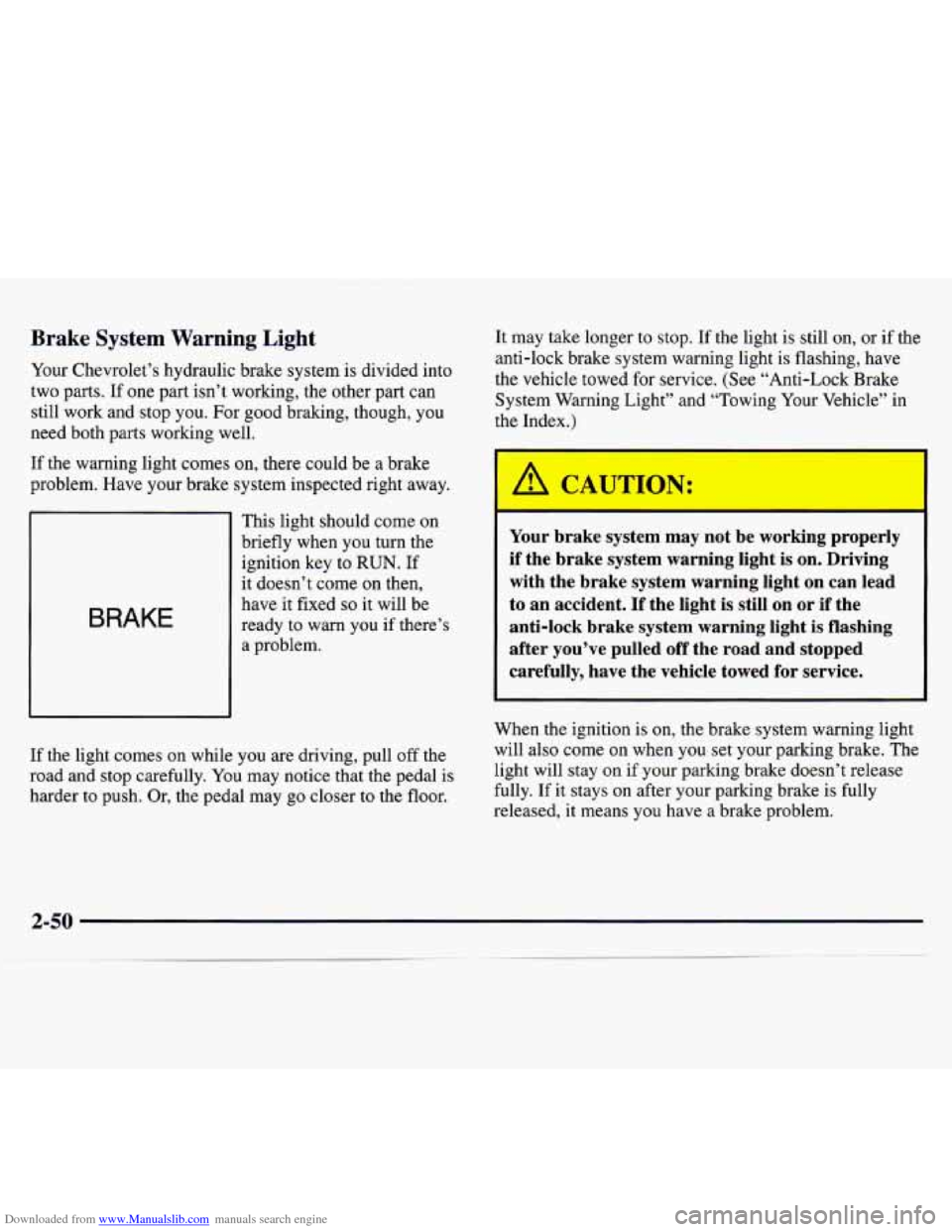
Downloaded from www.Manualslib.com manuals search engine Brake System Warning Light
Your Chevrolet’s hydraulic brake system is divided into
two parts. If
one part isn’t working, the other part can
still work and stop you. For good braking, though, you
need both parts working well.
If the warning light comes on, there could be a brake
problem. Have your brake system inspected right away.
BRAKE
This light should come on
briefly when you turn the
ignition key to
RUN. If
it doesn’t come on then,
have it fixed
so it will be
ready
to warn you if there’s
a problem.
If the light comes on while you are driving, pull off the
road and stop carefully. You may notice that the pedal
is
harder to push. Or, the pedal may go closer to the floor. It may take
longer to stop.
If the light is still on, or if the
anti-lock brake system warning light is flashing, have
the vehicle towed for service. (See “Anti-Lock Brake
System Warning Light” and “Towing Your Vehicle” in
the Index.)
Your brake system may not be working properly
if the brake system warning light is on. Driving
with the brake system warning light on can lead
to an accident. If the light is still on or if the
anti-lock brake system warning light is flashing
after you’ve pulled
off the road and stopped
carefully, have the vehicle towed for service.
When the ignition is on, the brake system warning light
will also come on when you set your parking brake. The
light will stay
on if your parking brake doesn’t release
fully.
If it stays on after your parking brake is fully
released, it means you have a brake problem.
Page 110 of 358

Downloaded from www.Manualslib.com manuals search engine Anti-Lock Brake System Warning Light
ANTI -
LOCK
With the anti-lock brake
system, this light will come
on when you start your
engine and
it will stay
on for three seconds.
That’s normal.
If the light flashes when you’re driving, you don’t have
anti-lock brakes and there could be a problem with your
regular brakes. Pull
off the road and stop carefully. You
may notice that the pedal
is harder to push. Or, the pedal
may go closer to the floor. It may take longer to stop.
Have the vehicle towed for service.
(See “Towing Your
Vehicle” in the Index.)
Your regular brake system may not be working
properly if the anti-lock brake system warning light is flashing. Driving with the anti-lock brake
system warning light flashing can lead to an accident. After you’ve pulled
off the road and
stopped carefully, have the vehicle towed for service.
If the anti-lock brake system warning light stays on
longer than normal after you’ve started your engine, turn
the ignition off. Or, if the light comes on and stays on
when you’re driving, stop
as soon as possible and turn
the ignition off. Then start the engine again to reset the
system.
If the light still stays on, or comes on again
while you’re driving, your Chevrolet needs service.
If
the light is on but not flashing and the regular brake
system warning light isn’t on, you still have
brakes, but
you don’t have anti-lock brakes.
The anti-lock brake system warning light should come
on briefly when you turn the ignition key
to RUN. If the
light doesn’t come on then, have it fixed
so it will be
ready to warn you if there
is a problem.
Page 112 of 358

Downloaded from www.Manualslib.com manuals search engine Engine Coolant Temperature Gage
You have a gage that
shows the engine coolant
temperature. If the gage
pointer moves into the red
area, your engine
is too hot!
That reading means the same thing as the warning light.
It means that your engine coolant has overheated. If you
have been operating your vehicle under normal driving
conditions, you should pull
off the road, stop your
vehicle and turn
off the engine as soon as possible.
In “Problems on the Road”, this manual shows what to
do. See “Engine Overheating” in the Index.
Low Coolant Warning Light
LOW
COOLANT
If this light comes on, your
system is low on coolant
and the engine may
overheat. See “Engine Coolant” in the Index and
have your vehicle serviced
as soon as you can.
2-53
Page 115 of 358
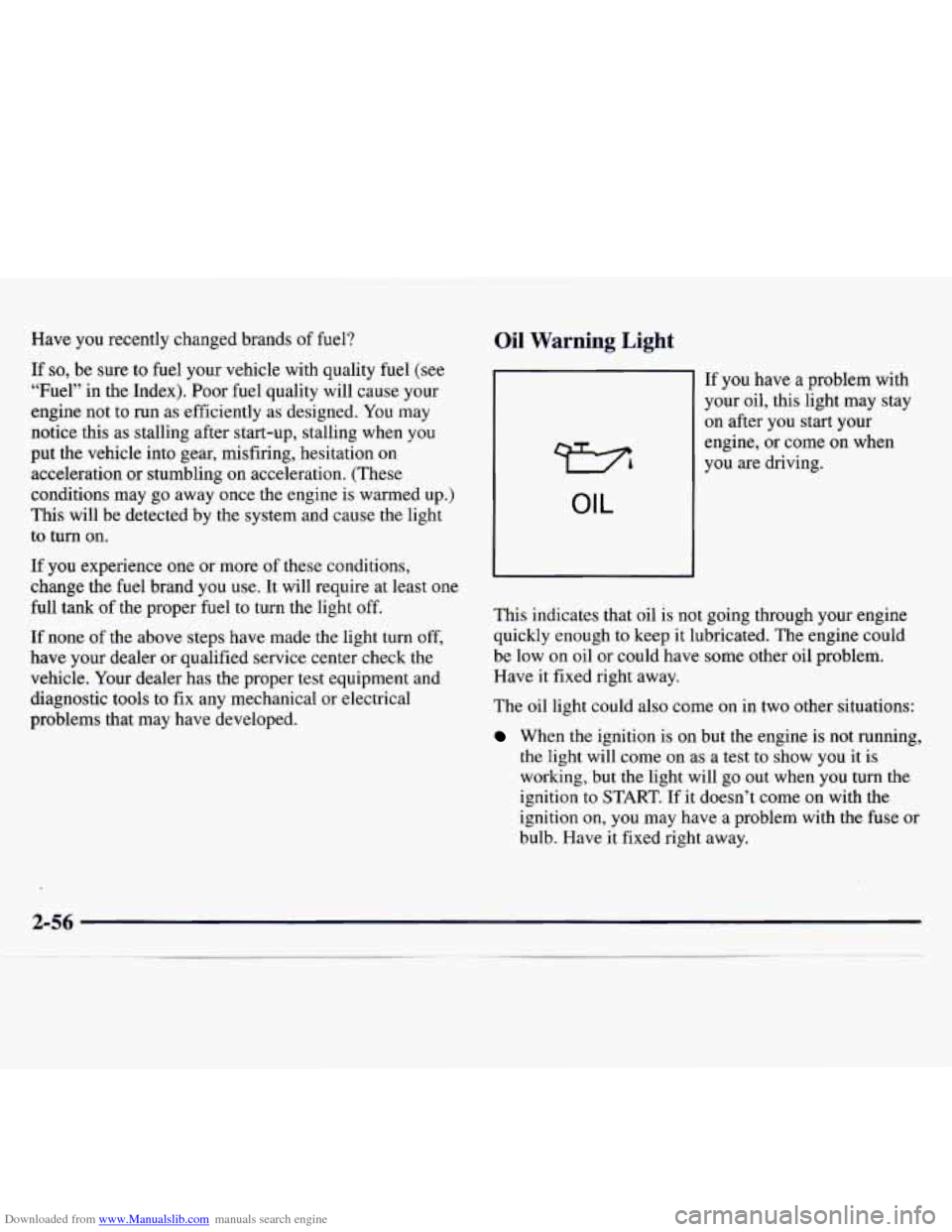
Downloaded from www.Manualslib.com manuals search engine Have you recently changed brands of fuel?
If
so, be sure to fuel your vehicle with quality fuel (see
“Fuel” in the Index). Poor fuel quality will cause your
engine not to run as efficiently as designed. You may
notice this as stalling after start-up, stalling when
you
put the vehicle into gear, misfiring, hesitation on
acceleration or stumbling on acceleration. (These
conditions may go away once the engine is warmed up.)
This will be detected by the system and cause the light
to turn on.
If
you experience one or more of these conditions,
change the fuel brand you use. It will require at least
one
full tank of the proper fuel to turn the light off.
If none of the above steps have made the light turn
off,
have your dealer or qualified service center check the
vehicle. Your dealer has the proper test equipment and
diagnostic tools to fix any mechanical or electrical
problems that may have developed.
Oil Warning Light
73
OIL
If you have a problem with
your oil, this light may stay
on after
you start your
engine, or come
on when
you are driving.
This indicates that oil is not going through your engine
quickly enough to keep it lubricated. The engine could
be low on oil or could have some other oil problem.
Have it fixed right away.
The
oil light could also come on in two other situations:
When the ignition is on but the engine is not running,
the light will come on as a test to show you
it is
working, but the light will go
out when you turn the
ignition to
START. If it doesn’t come on with the
ignition on, you may have a problem with the fuse or
bulb. Have it fixed right away.
Page 146 of 358
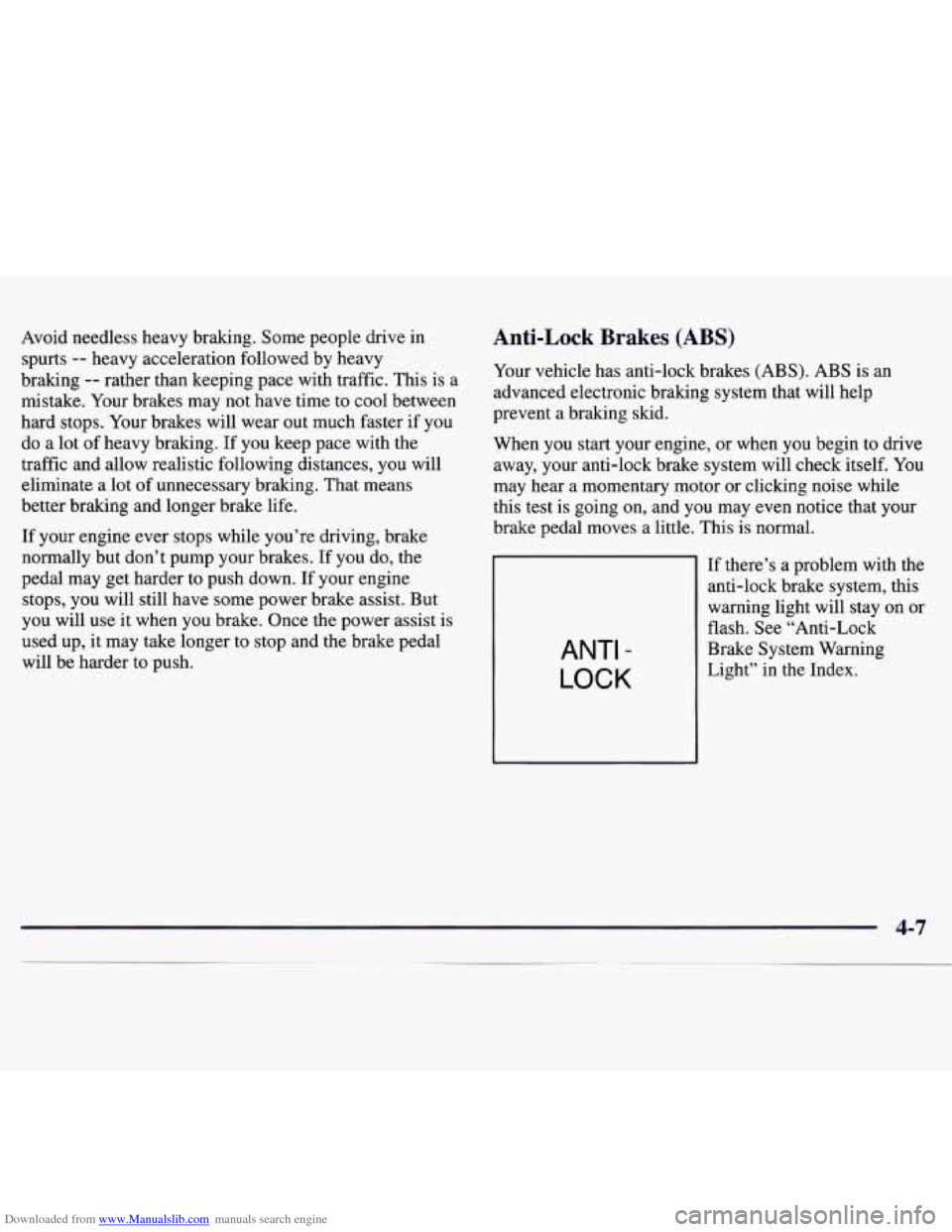
Downloaded from www.Manualslib.com manuals search engine Avoid needless heavy bralung. Some people drive in
spurts
-- heavy acceleration followed by heavy
braking
-- rather than keeping pace with traffic. This is a
mistake. Your brakes may not have time to cool between
hard stops. Your brakes will wear out much faster if you
do a lot of heavy braking. If you keep pace with the
traffic and allow realistic following distances, you will
eliminate a lot of unnecessary braking. That means
better braking and longer brake life.
If your engine ever stops while you’re driving, brake
normally but don’t pump your brakes. If you do, the
pedal may get harder to push down. If your engine
stops, you will still have some power brake assist. But
you will use it when you brake. Once the power assist
is
used up, it may take longer to stop and the brake pedal
will be harder to push.
Anti-Lock Brakes (ABS)
Your vehicle has anti-lock brakes (ABS). ABS is an
advanced electronic braking system that will help
prevent a braking skid.
When you start your engine,
or when you begin to drive
away, your anti-lock brake system will check itself. You
may hear a momentary motor or clicking noise while
this test
is going on, and you may even notice that your
brake pedal moves a little. This is normal.
ANTI -
LOCK
If there’s a problem with the
anti-lock brake system, this
warning light will stay on or
flash. See “Anti-Lock
Brake System Warning
Light” in the Index.